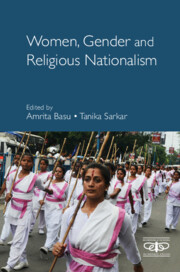Book contents
- Frontmatter
- Dedication
- Contents
- List of Abbreviations
- Introduction: Women of Hindu Rashtra
- Part I Changing Modalities of Hindu Nationalist Organizing
- Part II Gendered Techniques of Mobilization: The Sangh and the Samiti
- Part III Cultivating Women’s Militancy: The Vishva Hindu Parishad
- Part IV Refashioning Gender and Sexuality
- Part V Alternative Activist Responses to the Hindu Right
- Glossary
- About the Contributors
- Index
10 - The Revolution Will Come Wearing Bangles, Bindis and Hijabs: Women’s Activism for Inclusive Citizenship
Published online by Cambridge University Press: 12 August 2022
- Frontmatter
- Dedication
- Contents
- List of Abbreviations
- Introduction: Women of Hindu Rashtra
- Part I Changing Modalities of Hindu Nationalist Organizing
- Part II Gendered Techniques of Mobilization: The Sangh and the Samiti
- Part III Cultivating Women’s Militancy: The Vishva Hindu Parishad
- Part IV Refashioning Gender and Sexuality
- Part V Alternative Activist Responses to the Hindu Right
- Glossary
- About the Contributors
- Index
Summary
When about a dozen women organized a sit-in by blockading the Kalindi Kunj Road, which borders Shaheen Bagh in southeast Delhi, on 14 December 2019, no one predicted that they would launch a 101-day nationwide movement. As remarkable as the duration of the protest was its exuberant affirmation of inclusive nationalism and citizenship. The activists recited the national anthem at midnight on New Year's Eve, hoisted the tricolour on Republic Day and invited prime minister Narendra Modi to celebrate the festival of love together on Valentine's Day. Along with revolutionary speeches and readings of the Indian Constitution, protesters hosted performances by poets and musicians and decorated their tent with protest art. They forged community among people of different ages, faiths and social classes by sharing stories, reading, singing, painting, cooking and cleaning together. In Delhi's coldest winter in over 100 years, they knit each other shawls and sweaters and served hot tea to hundreds of supporters.
The women were protesting the government's passage of the Citizenship Amendment Act (CAA) and its calls for the creation of a National Register of Citizens (NRC), following recent police violence against student protesters at the nearby Jamia Millia Islamia University (hereafter Jamia). Within ten days, the sit-in grew to occupy half a mile of the highway, as it attracted thousands of supporters from across the city and later the country. The sit-in persisted, despite record-low temperatures, several court petitions seeking to evict the activists and false rumours that the Bharatiya Janata Party (BJP) spread, claiming that the protesters had been paid to resist the CAA and the NRC. The protesters remained peaceful and even distributed rose petals to their adversaries and the police, who ultimately evicted them and destroyed the protest site on 24 March 2020, when the government declared a lockdown to prevent the spread of Covid-19 (The Wire 2020a).
In this chapter we explore why Muslim women were at the forefront of the anti-CAA struggle and how their gendered experiences inform their affective relationship to citizenship. Before doing so, however, we provide some relevant background.
The CAA is the culmination of a series of steps the Modi-led BJP government has taken to establish Hindu domination and disenfranchise the Muslim community.
- Type
- Chapter
- Information
- Women, Gender and Religious Nationalism , pp. 301 - 336Publisher: Cambridge University PressPrint publication year: 2022

